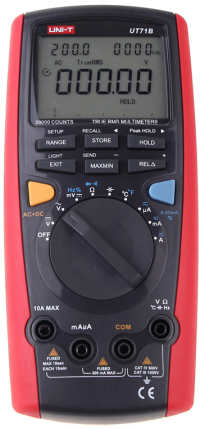- Deutsch (de)
- English (en)
The digital multimeter series UT71 from Uni-Trend

provides a cheap measurement solution with reasonable accuracy. The set includes an USB Interface Cable and a Windows based software. Unfortunately the USB Interface doesn't work with Mac OS X. But the optical interface can be easily soldered for less than 5.00 €.
| Qty | Part | Cost |
|---|---|---|
| 1 | PL2303HX or similar  | 3.00 € |
| 1 | IR-Fototransistor  | 0.10 € |
| 1 | IR-LED  | 0.10 € |
| 1 | 4k7  | 0.10 € |
| 1 | 1K0  | 0.10 € |
| 1 | PCB (very small piece)  | 0.50 € |
| 1 | Housing (3D print or laser cut)  | 0.50 € |
The USB to Serial converter PL2303HX provides 4 wires for the signals GND, +5V, RxD and TxD as shown in the schematic The TxD diode is optional and not supported by the software (yet).
 I used a laser cut housing based on 2mm white acryl. The design was prepared with Inkscape.
Depending on the thickness of your wiring you may not need all layers. In my example I only used 4 pieces.
I used a laser cut housing based on 2mm white acryl. The design was prepared with Inkscape.
Depending on the thickness of your wiring you may not need all layers. In my example I only used 4 pieces.
Cut and engrave on your laser cutter of choice. Prepare the small piece of PCB (perfboard). Glue the IR transistor (dark blue)and the IR LED. The flat part should be on the left for each. Solder the parts and the SMD resistors as shown on the picture. Last but not least connect the four wire of the PL2303HX.
The logic analyser revealed the following signal frame:
As we can see the multimeter sends 11 Bytes with 2400 Baud, 7 bits and ODD parity in ASCII format every approx. 650ms. With our built hardware we are now able to use a standard UART-program to analyse the protocol further. After some long iterations (and a lot of coffees) the eleven bytes have following meaning:
# Decode 11 bytes from UT71A/B/C
# ==============================
# Byte / Bit 6 5 4 3 2 1 0
# [0] Digit 1 0 1 1 =====Digit======
# [1] Digit 2 0 1 1 =====Digit======
# [2] Digit 3 0 1 1 =====Digit======
# [3] Digit 4 0 1 1 =====Digit======
# [4] Digit 5 0 1 1 =====Digit======
# [5] Range 0 1 1 0 =see below=
# [6] Unit 0 1 1 ====see below===
# [7] Coupling 0 1 1 0 0 DC AC (also DC and AC possible)
# [8] Info 0 1 1 0 NEG MAN AUTO (MAN or AUTO only)
# [9] '\r' 0 0 0 1 1 0 1
# [10] '\n' 0 0 0 1 0 1 0
#
# Digit: 0x30..0x39 = '0..9', 0x3A = ' ', 0x3B = '-', 0x3C = 'L', 0x3F = 'H'
# REL not sent
# No tansmission in HOLD state
# If NEG set at Range 15 sent value is duty cycle
# No LowBat info sent
# Storaged data not accessable
Depending on the chosen measuring range the Range and the Unit value lead to a corresponding multiplication factor:
Unit: 0 1 2 3 4 5 6 7 8 9 10 11 12 13 14 15
Range: mV V V mV Ω F °C µA mA A Pieps Diode Hz °F W %
'0' .01 - - .01 - - .1 .01 .001 - .01 .0001 .001 .1 - .01
'1' - .0001 .0001 - .01 .001 - .1 .01 .001 - - .01 - - -
'2' - .001 .001 - .0001 .01 - - - - - - .0001 - - -
'3' - .01 .01 - .001 .0001 - - - - - - .001 - - -
'4' - .1 .1 - .01 .001 - - - - - - .01 - - -
'5' - - - - .0001 .01 - - - - - - .0001 - - -
'6' - - - - .001 .0001 - - - - - - .001 - - -
'7' - - - - .01 .001 - - - - - - .01 - - -
Based on the protocol information I prepared a tiny Python program to receive the measured values, plot and store them as well as export in CSV format. This allows long-term measurements of any unit. The measurement values are stored in a SQLite database and can also be easily access with Open-Source tools like DB Browser for SQLite.
If you like my articles feel to donate a cappuccino or so…